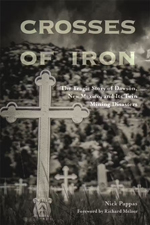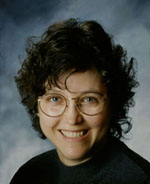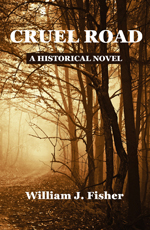Award-winning journalist and editor Nick Pappas spent much of his 40-plus-year career in several New England states before taking the position of city editor at the Albuquerque Journal. After retiring, research into coal-mine catastrophes in northern New Mexico culminated in his debut release of Crosses of Iron: The Tragic Story of Dawson, New Mexico, and its Twin Mining Disasters (University of New Mexico Press, October 2023). You’ll find Nick on his website NickPappasBooks.com, on Facebook, LinkedIn, and Twitter/X. Look for his book at all major retailers, including University of New Mexico Press and Amazon.
 Crosses of Iron: The Tragic Story of Dawson, New Mexico, and its Twin Mining Disasters is a sad, but fascinating topic. What drew you to tell the story of these miners?
Crosses of Iron: The Tragic Story of Dawson, New Mexico, and its Twin Mining Disasters is a sad, but fascinating topic. What drew you to tell the story of these miners?
My wife Susan and I moved to Albuquerque from New Hampshire in June 2013 so I could start a new job at the Albuquerque Journal. As it turns out, the 100-year anniversary of Dawson’s 1913 mine disaster — the second deadliest in U.S. history — was commemorated that October with stories in the Journal, Santa Fe New Mexican, and other media outlets. At first, I was struck by the sheer horror of that incident (263 dead) and another explosion a decade later that claimed the lives of another 120 men. Over time, however, I came to realize there was so much more to Dawson’s history. Once I realized that former residents, descendants, and friends still gathered every other Labor Day weekend for a picnic reunion on the old townsite — nearly 70 years after the town shut down in 1950 — I was hooked. I began work on a narrative history of the old coal town after I retired in November 2018.
Please give our readers a glimpse of what Dawson, New Mexico was like in the early 1900s.
Once acquired by Phelps, Dodge & Company in 1905, Dawson became a model for coal towns across the Southwest, if not the country. Within a decade or so, Dawson was home to a 1,000-seat opera house, a large mercantile store than sent buyers to New York to acquire the latest furs and fashions, a state-of-the-art hospital and dispensary, full-service bank, top-notch schools, two churches, gymnasium, swimming pool and, at the time, the highest-elevation golf course in the nation. It also became a magnet for European immigrants from more than a dozen countries, as well as from China, Mexico, and Russia. And to hear former residents tell it, Dawson was a wonderful place to live, at least when measured against other coal camps of the day.
How accessible/plentiful was the information regarding these disasters when writing this story? Was there an oral history from descendants? How did families feel about their ancestor’s story finally being told?
I tried whenever possible to rely on primary documents, original newspaper accounts, and personal interviews. Among the source materials were annual territorial and state mine inspector reports, government documents and studies, company annual reports, industry research and newsletters, unpublished manuscripts, first-person accounts, and similar material. My biggest break was obtaining access to boxloads of company documents held today by the successor company to Phelps Dodge in Arizona. These materials included hundreds of pages of intracompany communications, letters, telegrams and the like specific to the 1913 mine disaster and its aftermath. As for families with ties to Dawson, they couldn’t have been more gracious in sharing their time, photographs and, in some cases, translations of letters and newspaper accounts from their native Greek and Italian.
What were some of the obstacles you faced while writing Crosses of Iron?
The first was the outbreak of COVID-19 roughly 14 months after I had begun my research. Fortunately, I already had visited most of the pertinent New Mexico archives and libraries before they shut down, though there were others outside of the state that I would have liked to visit. Otherwise, there were some iconic Dawson photographs I would have liked to include in the book, especially those related to the town’s closing in 1950, but I was never able to track down the original owner/source to use them. And then there was the discrepancy in the spelling of immigrant names, which many times differed markedly among ship manifests, census reports, military documents, company records and especially in newspaper accounts. When it came to listing the names of the 383 miners who died in the 1913 and 1923 mine disasters in the back of the book, I decided to go with the spellings contained in the official New Mexico mine inspector reports for those years, even though I knew from talking to families that at least some were not accurate.
You mentioned that you’re a native New Englander. Are there any stories from that area that you’ve been inspired to tell?
None immediately come to mind, but if I ever were to move back, I’d like to think I could find an overlooked or forgotten piece of history to pique my interest.
This would make a great documentary. Are there any plans for Crosses of Iron to make it to the big screen?
Not that I am aware. There was a serious effort a few years back by a Santa Fe-based company to produce a one-hour documentary told through the perspective of three immigrant communities. The documentary was to be filmed on location in New Mexico, Italy, Greece, and Mexico, but the project fell through due to a lack of funding.
What was your favorite part of putting this project together?
Probably the research, whether working with families, the always helpful custodians at the State’s archives and libraries, or seeking out old documents. To be honest, I was amazed at some of the material I was able to discover online too. Case in point: The 1904 edition of The Shield, a Phi Kappa Psi magazine that contained critical background information on a Brown University graduate who would later lose his life in the 1913 mine explosion. The pleasure that came from sharing with families previously unknown details about their loved ones was an added bonus.
Is there a particular path or routine you follow when working on a project of this nature?
This was my first book, so it was more a seat-of-the-pants exercise than a rigid adherence to tried and true rules. In my case, the path looked something like this: Research. Interview. Write. Rewrite. Edit. Edit. And then edit some more.
What’s next on your radar for writing projects?
I have a few ideas rooted in New Mexico history but nothing definite yet.
Is there anything else you’d like readers to know?
Only that Crosses of Iron is more than a disaster book. Given that most of the story is set in the first half of the 20th century, the book chronicles some key events in our nation’s history: the massive wave of European immigration that brought 20-million people to America between 1880 and 1920 (in its heyday, more than a dozen languages were spoken in Dawson), the Ludlow Massacre of 1914, the Spanish flu pandemic of 1918-19, Prohibition, the rise of the American labor movement, World Wars I and II, and other important milestones. And the book concludes with onetime Dawson residents — including American labor icon Dolores Huerta — or those with a strong connection to Dawson sharing memories of their beloved coal town.
 Su Lierz writes dark fiction, short story fiction, and personal essays. Her short story “Twelve Days in April,” written under the pen name Laney Payne, appeared in the 2018 SouthWest Writers Sage Anthology. Su was a finalist in the 2017 and 2018 Albuquerque Museum Authors Festival Writing Contest. She lives in Corrales, New Mexico, with her husband Dennis.
Su Lierz writes dark fiction, short story fiction, and personal essays. Her short story “Twelve Days in April,” written under the pen name Laney Payne, appeared in the 2018 SouthWest Writers Sage Anthology. Su was a finalist in the 2017 and 2018 Albuquerque Museum Authors Festival Writing Contest. She lives in Corrales, New Mexico, with her husband Dennis.


 KL Wagoner (writing as Cate Macabe) is the author of This New Mountain: a memoir of AJ Jackson, private investigator, repossessor, and grandmother. Kat has a speculative fiction blog at
KL Wagoner (writing as Cate Macabe) is the author of This New Mountain: a memoir of AJ Jackson, private investigator, repossessor, and grandmother. Kat has a speculative fiction blog at 











